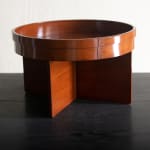




artisan's name unknown
Lacquer Tray with legs, Late 1800s to Early 1900s
Lacquer on Wood
11 1/2" dia. x 6 1/2" h
Further images
This round lacquer tray is called a Marugatanoshi-dai in Japanese. It is a tray upon which symbolic items are placed for ceremonial greetings. For example, this type of tray is...
This round lacquer tray is called a Marugatanoshi-dai in Japanese. It is a tray upon which symbolic items are placed for ceremonial greetings. For example, this type of tray is used in hand-delivering a New Year’s greeting gift from one family to another. Traditionally, a personal assistant wearing a haori-hakama (most formal attire) deliver these greetings.
These days the custom itself is no longer practiced and the trays have become obsolete. Yet, recognizing the stunning beauty of its design, the harmony of curved and straight lines in perfect proportions, as well as its enduring quality, only being used 15-20 times per generation, its possibilities as a work of beauty are endless.
The lacquer applied is called Shunkei-Nuri. A light, yellow-ish brown stain is thinly applied onto wood and a transparent lacquer is applied over it. As a result, the finishing preserves the feel of the wood, with the color aging elegantly to a rich, light-brown.
This table is a symphony of function, simplicity in design, and masterful usage of wood, joinery, and lacquer techniques. Imagine this round tray in a minimalistic room with a few colors and a few lines. Now, place an intriguing, small, contemporary sculpture on it, or adore it as an object of beauty in and of itself. This stunning piece is waiting for the taste and vision of a new steward to reinterpret it for the 21st century.
These days the custom itself is no longer practiced and the trays have become obsolete. Yet, recognizing the stunning beauty of its design, the harmony of curved and straight lines in perfect proportions, as well as its enduring quality, only being used 15-20 times per generation, its possibilities as a work of beauty are endless.
The lacquer applied is called Shunkei-Nuri. A light, yellow-ish brown stain is thinly applied onto wood and a transparent lacquer is applied over it. As a result, the finishing preserves the feel of the wood, with the color aging elegantly to a rich, light-brown.
This table is a symphony of function, simplicity in design, and masterful usage of wood, joinery, and lacquer techniques. Imagine this round tray in a minimalistic room with a few colors and a few lines. Now, place an intriguing, small, contemporary sculpture on it, or adore it as an object of beauty in and of itself. This stunning piece is waiting for the taste and vision of a new steward to reinterpret it for the 21st century.
Signup for our Newsletter
You will receive two emails a month from us. One introduces artworks and design works from Kyoto's hidden sources and the other is stories from Misako, sharing insights into Japanese culture.
* denotes required fields
为了回应您的查询,我们将根据我们的隐私政策处理您提供的个人数据。




